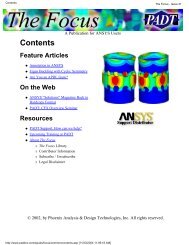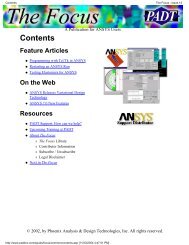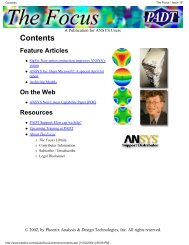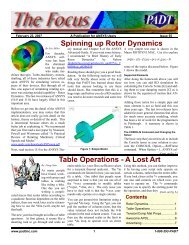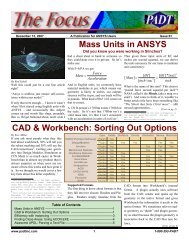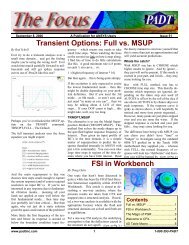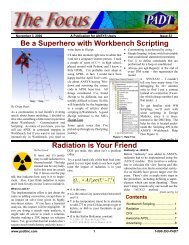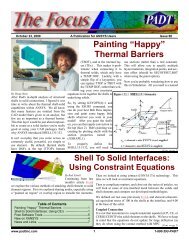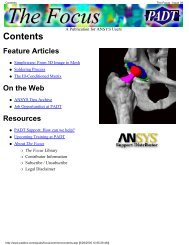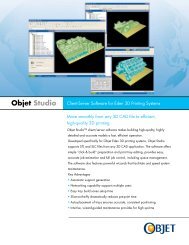Modeling Cracks with ANSYS Maximizing the ROI on your ... - PADT
Modeling Cracks with ANSYS Maximizing the ROI on your ... - PADT
Modeling Cracks with ANSYS Maximizing the ROI on your ... - PADT
You also want an ePaper? Increase the reach of your titles
YUMPU automatically turns print PDFs into web optimized ePapers that Google loves.
June 18, 2010 The Focus Issue 74<br />
June 18, 2010 A Publicati<strong>on</strong> for <str<strong>on</strong>g>ANSYS</str<strong>on</strong>g> Users Issue 74<br />
Instead of using cheesy graphics <str<strong>on</strong>g>with</str<strong>on</strong>g> m<strong>on</strong>ey bags, scales,<br />
and overly attractive “employees” in meetings, we decided to<br />
dress up this article <str<strong>on</strong>g>with</str<strong>on</strong>g> pictures from around Ariz<strong>on</strong>a. This is<br />
from <str<strong>on</strong>g>the</str<strong>on</strong>g> top of Four Peaks, <str<strong>on</strong>g>the</str<strong>on</strong>g> mountains east of Phoenix.<br />
<str<strong>on</strong>g>Maximizing</str<strong>on</strong>g> <str<strong>on</strong>g>the</str<strong>on</strong>g> <str<strong>on</strong>g>ROI</str<strong>on</strong>g> <strong>on</strong><br />
<strong>your</strong> CAE Investment<br />
By Eric Miller<br />
If you are reading this article you are ei<str<strong>on</strong>g>the</str<strong>on</strong>g>r a practiti<strong>on</strong>er of Computer Aided<br />
Engineering or you are stuck <strong>on</strong> a desert island and this is <str<strong>on</strong>g>the</str<strong>on</strong>g> <strong>on</strong>ly thing you have<br />
to read. Let's assume <str<strong>on</strong>g>the</str<strong>on</strong>g> former. If you boil down why <strong>your</strong> company does<br />
CAE, you should come to <strong>on</strong>e or both of <str<strong>on</strong>g>the</str<strong>on</strong>g> following reas<strong>on</strong>s: to reduce <strong>your</strong><br />
costs for physical prototyping and/or to increase <str<strong>on</strong>g>the</str<strong>on</strong>g> number of design iterati<strong>on</strong>s<br />
through <str<strong>on</strong>g>the</str<strong>on</strong>g> use of virtual prototypes. Study after study, even <strong>on</strong>es not paid for<br />
by CAE software companies, show that leading companies use more CAE,<br />
earlier in <str<strong>on</strong>g>the</str<strong>on</strong>g> design cycle. Figure 1 shows <str<strong>on</strong>g>the</str<strong>on</strong>g> results of <strong>on</strong>e such study from<br />
<str<strong>on</strong>g>the</str<strong>on</strong>g> Aberdeen Group.<br />
You may be new to CAE, or a 20+ year user. Ei<str<strong>on</strong>g>the</str<strong>on</strong>g>r way, how does <strong>your</strong> company maximize <str<strong>on</strong>g>the</str<strong>on</strong>g> return from <str<strong>on</strong>g>the</str<strong>on</strong>g>ir investment in you,<br />
<strong>your</strong> co-workers, <str<strong>on</strong>g>the</str<strong>on</strong>g> software and <str<strong>on</strong>g>the</str<strong>on</strong>g> hardware? And do not forget that annual maintenance fee you pay. <strong>PADT</strong>'s internal experience<br />
and less<strong>on</strong>s learned from our customers, leads us to recommend that <str<strong>on</strong>g>the</str<strong>on</strong>g> best way to get <str<strong>on</strong>g>the</str<strong>on</strong>g> most out of that investment (C<strong>on</strong>t. <strong>on</strong> pg. 2)<br />
Issue 74, <str<strong>on</strong>g>the</str<strong>on</strong>g> Last “Magazine” Style Issue of The Focus<br />
It is hard to believe that <str<strong>on</strong>g>the</str<strong>on</strong>g> next issue of The Focus will be <str<strong>on</strong>g>the</str<strong>on</strong>g> 75th! We hope you have enjoyed reading it as much as we have<br />
enjoyed making it. As we prepared this issue we came to <str<strong>on</strong>g>the</str<strong>on</strong>g> realizati<strong>on</strong> that this format has served its purpose and that various<br />
Internet based publishing tools have matured to <str<strong>on</strong>g>the</str<strong>on</strong>g> point where it is time to make a change. We are leaning towards more of a<br />
blog approach where we put out single articles <strong>on</strong>ce every o<str<strong>on</strong>g>the</str<strong>on</strong>g>r week or so, instead of <str<strong>on</strong>g>the</str<strong>on</strong>g> big issue.<br />
So look for a lot of changes to how we publish and distribute The Focus in <str<strong>on</strong>g>the</str<strong>on</strong>g> coming m<strong>on</strong>ths. And thank you again for every<strong>on</strong>e's<br />
c<strong>on</strong>tinued support of this publicati<strong>on</strong>!<br />
In this Issue...<br />
1........<str<strong>on</strong>g>Maximizing</str<strong>on</strong>g> <str<strong>on</strong>g>the</str<strong>on</strong>g> <str<strong>on</strong>g>ROI</str<strong>on</strong>g> <strong>on</strong> <strong>your</strong><br />
CAE Investment<br />
1........Part 2: <str<strong>on</strong>g>Modeling</str<strong>on</strong>g> <str<strong>on</strong>g>Cracks</str<strong>on</strong>g> <str<strong>on</strong>g>with</str<strong>on</strong>g><br />
<str<strong>on</strong>g>ANSYS</str<strong>on</strong>g><br />
5........Thin Sweep: Sweeping Away<br />
Sweep Mesh Restricti<strong>on</strong>s<br />
9........Banishing <str<strong>on</strong>g>the</str<strong>on</strong>g> Bad Geometry<br />
Blues <str<strong>on</strong>g>with</str<strong>on</strong>g> Design Modeler<br />
8........Training Schedule<br />
11......About <strong>PADT</strong><br />
You do an article <strong>on</strong> crack modeling, and<br />
you have to go <str<strong>on</strong>g>with</str<strong>on</strong>g> <str<strong>on</strong>g>the</str<strong>on</strong>g> classic “fat guys<br />
<strong>on</strong> a stool” pictures. No Choice.<br />
Part 2<br />
<str<strong>on</strong>g>Modeling</str<strong>on</strong>g><br />
<str<strong>on</strong>g>Cracks</str<strong>on</strong>g> <str<strong>on</strong>g>with</str<strong>on</strong>g><br />
<str<strong>on</strong>g>ANSYS</str<strong>on</strong>g><br />
<str<strong>on</strong>g>ANSYS</str<strong>on</strong>g> supports several of <str<strong>on</strong>g>the</str<strong>on</strong>g> comm<strong>on</strong> techniques used to analyze cracks. In a<br />
typical first analysis, an engineer assumes a flaw shape and size and <str<strong>on</strong>g>the</str<strong>on</strong>g>n uses <str<strong>on</strong>g>the</str<strong>on</strong>g><br />
stress results from an FEA model as input into NASGRO. If a more detailed<br />
simulati<strong>on</strong> is required, an FEA model <str<strong>on</strong>g>with</str<strong>on</strong>g> a crack included can be created.<br />
There are a few guidelines for using <str<strong>on</strong>g>ANSYS</str<strong>on</strong>g> to model cracks, <str<strong>on</strong>g>the</str<strong>on</strong>g> guidelines will<br />
be dem<strong>on</strong>strated through an example of a steel turbine wheel, shown in Figure 1,<br />
which has been assumed to have a crack introduced during <str<strong>on</strong>g>the</str<strong>on</strong>g> balancing process.<br />
A link to <str<strong>on</strong>g>the</str<strong>on</strong>g> geometry model (v12 UP20090415) and APDL command files are<br />
provided at <str<strong>on</strong>g>the</str<strong>on</strong>g> end of this article in order to allow <str<strong>on</strong>g>the</str<strong>on</strong>g> user to reproduce this<br />
analysis step by step.<br />
(C<strong>on</strong>t. <strong>on</strong> pg. 7)<br />
www.padtinc.com 1 1-800-293-<strong>PADT</strong>
June 18, 2010 The Focus Issue 74<br />
(<str<strong>on</strong>g>ROI</str<strong>on</strong>g>, C<strong>on</strong>t...)<br />
is to focus <strong>on</strong> four key aspects of CAE: goals, people, tools, and process. In this<br />
article we will talk about each and how to make each aspect work for you.<br />
Goals<br />
If you have every read an article or attended a seminar hosted by <strong>PADT</strong> <strong>on</strong> being<br />
more efficient/productive you will always hear us start off <str<strong>on</strong>g>with</str<strong>on</strong>g> goals. We feel<br />
that a lack of clear goals is a huge productivity killer. We find again and again<br />
that companies or teams that successfully use CAE have clear goals for <str<strong>on</strong>g>the</str<strong>on</strong>g>ir<br />
entire CAE effort. Goals that <str<strong>on</strong>g>the</str<strong>on</strong>g>y develop, document, and modify as needed.<br />
As an example, <strong>PADT</strong>'s CAE goal is: To answer questi<strong>on</strong>s raised in product<br />
development in <str<strong>on</strong>g>the</str<strong>on</strong>g> most cost effective manner <str<strong>on</strong>g>with</str<strong>on</strong>g> <str<strong>on</strong>g>the</str<strong>on</strong>g> proper level of accuracy<br />
and detail. It may not roll of <str<strong>on</strong>g>the</str<strong>on</strong>g> t<strong>on</strong>gue but it gets <str<strong>on</strong>g>the</str<strong>on</strong>g> job d<strong>on</strong>e and helps keep<br />
us from going off track.<br />
Just as every organizati<strong>on</strong> should have goals for <str<strong>on</strong>g>the</str<strong>on</strong>g>ir total CAE effort, <str<strong>on</strong>g>the</str<strong>on</strong>g>y<br />
should also get into <str<strong>on</strong>g>the</str<strong>on</strong>g> habit of forming goals for each CAE task <str<strong>on</strong>g>the</str<strong>on</strong>g>y undertake.<br />
This does not need to be formal but should at least address what you want from<br />
<str<strong>on</strong>g>the</str<strong>on</strong>g> calculati<strong>on</strong>s you are doing and how accurate <str<strong>on</strong>g>the</str<strong>on</strong>g>y need to be. You should<br />
write <str<strong>on</strong>g>the</str<strong>on</strong>g>m out, kind of like a customer specificati<strong>on</strong> and <str<strong>on</strong>g>the</str<strong>on</strong>g>y should never be l<strong>on</strong>ger than <strong>on</strong>e sentence.<br />
Once <str<strong>on</strong>g>the</str<strong>on</strong>g>y are written down<br />
<str<strong>on</strong>g>the</str<strong>on</strong>g>y can help <str<strong>on</strong>g>the</str<strong>on</strong>g> engineers involved in <str<strong>on</strong>g>the</str<strong>on</strong>g> middle of <str<strong>on</strong>g>the</str<strong>on</strong>g> project, and will help new engineers understand why <str<strong>on</strong>g>the</str<strong>on</strong>g>y are doing <str<strong>on</strong>g>the</str<strong>on</strong>g> CAE<br />
tasks that <str<strong>on</strong>g>the</str<strong>on</strong>g>y have been assigned. Example task goals could be:<br />
· Determine cooling hole size and distributi<strong>on</strong> to obtain required wafer cool down in between 45 and 60 sec<strong>on</strong>ds<br />
· Report LCF and HCF life based up<strong>on</strong> customer supplied loading specificati<strong>on</strong><br />
· Modify antenna design to minimize material costs and meet signal strength requirements in ES 123.31<br />
· Determine min, max and average percent enobarnotopital to provide a between 95% and 99% probanotinaium yield<br />
If <str<strong>on</strong>g>the</str<strong>on</strong>g> tasks are part of a major effort, it might not be a bad idea to review <str<strong>on</strong>g>the</str<strong>on</strong>g>m weekly. Making goal setting and review part of <strong>your</strong><br />
CAE culture can have a huge impact — keeping projects <strong>on</strong> focus, under budget and most importantly, delivering <str<strong>on</strong>g>the</str<strong>on</strong>g> informati<strong>on</strong> that<br />
<str<strong>on</strong>g>the</str<strong>on</strong>g> design team actually wants.<br />
People<br />
It is hard to understate <str<strong>on</strong>g>the</str<strong>on</strong>g> importance of people in making a CAE effort a<br />
success, a failure, or just so-so. From key super users to engineers who are in<br />
over <str<strong>on</strong>g>the</str<strong>on</strong>g>ir heads, people are <str<strong>on</strong>g>the</str<strong>on</strong>g> most important aspect of getting <str<strong>on</strong>g>the</str<strong>on</strong>g> most out of<br />
<strong>your</strong> CAE investment. They are also <str<strong>on</strong>g>the</str<strong>on</strong>g> hardest to c<strong>on</strong>trol.<br />
Dig deep into companies that are true CAE superstars — time and time again<br />
you will find <strong>on</strong>e or more key users. Some call <str<strong>on</strong>g>the</str<strong>on</strong>g>m gurus, some are called<br />
power users, and still o<str<strong>on</strong>g>the</str<strong>on</strong>g>rs are simply referred to as simulati<strong>on</strong> gods. We prefer<br />
<str<strong>on</strong>g>the</str<strong>on</strong>g> less charged term "key users." They prove that <strong>on</strong>e pers<strong>on</strong> can make a<br />
difference by pushing technology and applying it properly. They also help<br />
management make smart tool decisi<strong>on</strong>s. Most importantly <str<strong>on</strong>g>the</str<strong>on</strong>g>y mentor, train,<br />
and serve as examples for <str<strong>on</strong>g>the</str<strong>on</strong>g> o<str<strong>on</strong>g>the</str<strong>on</strong>g>r users in <str<strong>on</strong>g>the</str<strong>on</strong>g> organizati<strong>on</strong>. Sometimes <str<strong>on</strong>g>the</str<strong>on</strong>g>se<br />
key users are simply users, sometimes <str<strong>on</strong>g>the</str<strong>on</strong>g>y are managers or members of methods<br />
teams. Regardless of where <str<strong>on</strong>g>the</str<strong>on</strong>g>y come from <str<strong>on</strong>g>the</str<strong>on</strong>g>y share some comm<strong>on</strong> characteristics:<br />
· Balance between <str<strong>on</strong>g>the</str<strong>on</strong>g>ory and practical<br />
· Creative, willing to experiment and try different ways<br />
· Fast thinkers<br />
· Obsessed <str<strong>on</strong>g>with</str<strong>on</strong>g> efficiency<br />
· Learn things quickly <str<strong>on</strong>g>with</str<strong>on</strong>g> minimal input<br />
· Good at programming/scripting<br />
· Involved in real world applicati<strong>on</strong>s<br />
· Str<strong>on</strong>g computer skills<br />
A picture from Sed<strong>on</strong>a looking up to <str<strong>on</strong>g>the</str<strong>on</strong>g> Red Rocks. Notice<br />
<str<strong>on</strong>g>the</str<strong>on</strong>g> reflecti<strong>on</strong> in <str<strong>on</strong>g>the</str<strong>on</strong>g> pool. This is a required shot for all visitors<br />
to Sed<strong>on</strong>a.<br />
Oak Creek Cany<strong>on</strong> is <strong>on</strong>e of <str<strong>on</strong>g>the</str<strong>on</strong>g> green oases that we go nuts<br />
for here. People back east have this sort of thing in <str<strong>on</strong>g>the</str<strong>on</strong>g>ir<br />
backyard but for us it is a big deal.<br />
If you are a key user, embrace it and work to help make <strong>your</strong> organizati<strong>on</strong> better. If you are a manager or user who sees <str<strong>on</strong>g>the</str<strong>on</strong>g> need, work<br />
to grow key users by identifying <str<strong>on</strong>g>the</str<strong>on</strong>g>m and encouraging <str<strong>on</strong>g>the</str<strong>on</strong>g>m to take <strong>on</strong> a str<strong>on</strong>g role. Then focus <strong>on</strong> keeping <str<strong>on</strong>g>the</str<strong>on</strong>g>m engaged in key<br />
activities and decisi<strong>on</strong>s. Doing so will be <strong>on</strong>e of <str<strong>on</strong>g>the</str<strong>on</strong>g> best investments any organizati<strong>on</strong> can make.<br />
(C<strong>on</strong>t. <strong>on</strong> pg. 3)<br />
www.padtinc.com 2 1-800-293-<strong>PADT</strong>
June 18, 2010 The Focus Issue 74<br />
(<str<strong>on</strong>g>ROI</str<strong>on</strong>g>, C<strong>on</strong>t...)<br />
On <str<strong>on</strong>g>the</str<strong>on</strong>g> o<str<strong>on</strong>g>the</str<strong>on</strong>g>r end of <str<strong>on</strong>g>the</str<strong>on</strong>g> spectrum, and just as powerful, is <str<strong>on</strong>g>the</str<strong>on</strong>g> anti-particle to <str<strong>on</strong>g>the</str<strong>on</strong>g><br />
key user — <str<strong>on</strong>g>the</str<strong>on</strong>g> bad user. We would like to live in a world where "every<strong>on</strong>e gets a<br />
trophy" but in <str<strong>on</strong>g>the</str<strong>on</strong>g> real world some people should not be involved in computer aided<br />
engineering. A few are bad users by nature. They are generally too practical or too<br />
<str<strong>on</strong>g>the</str<strong>on</strong>g>oretical. They also do not remember steps in a process or have a lack of c<strong>on</strong>cern<br />
about speed. Lastly <str<strong>on</strong>g>the</str<strong>on</strong>g>y are often not computer experts and get stuck a lot,<br />
struggling <str<strong>on</strong>g>with</str<strong>on</strong>g> solving problems independently. The key thing is to find people<br />
like this and take <str<strong>on</strong>g>the</str<strong>on</strong>g>m out of CAE. There are plenty of o<str<strong>on</strong>g>the</str<strong>on</strong>g>r engineering tasks out<br />
<str<strong>on</strong>g>the</str<strong>on</strong>g>re that may be a better fit for this type of pers<strong>on</strong>.<br />
However, <str<strong>on</strong>g>the</str<strong>on</strong>g> more comm<strong>on</strong> bad user is not bad by nature, <str<strong>on</strong>g>the</str<strong>on</strong>g>y are bad by nurture.<br />
A perfectly capable engineer can do a rotten job at CAE because <str<strong>on</strong>g>the</str<strong>on</strong>g>ir company did<br />
not use <str<strong>on</strong>g>the</str<strong>on</strong>g>m properly. Typical problems are not enough training, spreading <str<strong>on</strong>g>the</str<strong>on</strong>g>m<br />
too thin or not giving <str<strong>on</strong>g>the</str<strong>on</strong>g>m <str<strong>on</strong>g>the</str<strong>on</strong>g> compute horsepower <str<strong>on</strong>g>the</str<strong>on</strong>g>y need. It is also comm<strong>on</strong><br />
to not allow <str<strong>on</strong>g>the</str<strong>on</strong>g>m to do CAE often enough to be good at it. Even if those problems<br />
do not exist you can get bad results by giving people unreas<strong>on</strong>able schedules,<br />
Up in Nor<str<strong>on</strong>g>the</str<strong>on</strong>g>rn Ariz<strong>on</strong>a <strong>on</strong> <str<strong>on</strong>g>the</str<strong>on</strong>g> Navajo Nati<strong>on</strong> <str<strong>on</strong>g>the</str<strong>on</strong>g>re are<br />
<str<strong>on</strong>g>the</str<strong>on</strong>g>se incredible slot cany<strong>on</strong>s. Cut by wind and water,<br />
<str<strong>on</strong>g>the</str<strong>on</strong>g> way <str<strong>on</strong>g>the</str<strong>on</strong>g> light shines down is incredible.<br />
unrealistic expectati<strong>on</strong>s or punishing <str<strong>on</strong>g>the</str<strong>on</strong>g>m for delivering bad news. The good thing about some<strong>on</strong>e who is a bad user because of external<br />
influence is that you can flip <str<strong>on</strong>g>the</str<strong>on</strong>g>m into being a good user by removing <str<strong>on</strong>g>the</str<strong>on</strong>g> negative parts of <str<strong>on</strong>g>the</str<strong>on</strong>g>ir envir<strong>on</strong>ment.<br />
In talking about key users and bad users, we have left out <str<strong>on</strong>g>the</str<strong>on</strong>g> largest group of users - <str<strong>on</strong>g>the</str<strong>on</strong>g> mainstream day to day engineers who do <str<strong>on</strong>g>the</str<strong>on</strong>g><br />
bulk of <str<strong>on</strong>g>the</str<strong>on</strong>g> CAE work. Because <str<strong>on</strong>g>the</str<strong>on</strong>g>y are <str<strong>on</strong>g>the</str<strong>on</strong>g> largest group, it is important to remain focused <strong>on</strong> <str<strong>on</strong>g>the</str<strong>on</strong>g>m. Make sure <strong>your</strong> organizati<strong>on</strong><br />
maximizes <strong>your</strong> c<strong>on</strong>siderable investment in <str<strong>on</strong>g>the</str<strong>on</strong>g>m by making some key commitments like giving <str<strong>on</strong>g>the</str<strong>on</strong>g>m <str<strong>on</strong>g>the</str<strong>on</strong>g> proper hardware and software<br />
that <str<strong>on</strong>g>the</str<strong>on</strong>g>y need. Then provide <str<strong>on</strong>g>the</str<strong>on</strong>g>m <str<strong>on</strong>g>the</str<strong>on</strong>g> time to learn those tools, clear goals, and encouraging <str<strong>on</strong>g>the</str<strong>on</strong>g>m to work toge<str<strong>on</strong>g>the</str<strong>on</strong>g>r and share <str<strong>on</strong>g>the</str<strong>on</strong>g>ir<br />
knowledge and skill.<br />
In short, focus <strong>on</strong> <strong>your</strong> people and <str<strong>on</strong>g>the</str<strong>on</strong>g>y will deliver for you. Encourage <str<strong>on</strong>g>the</str<strong>on</strong>g> truly capable and nurture <str<strong>on</strong>g>the</str<strong>on</strong>g> average users. And do not be<br />
afraid to move those who are not a good match for CAE out of <str<strong>on</strong>g>the</str<strong>on</strong>g> area.<br />
Tools<br />
When people think about CAE, most of <str<strong>on</strong>g>the</str<strong>on</strong>g> time <str<strong>on</strong>g>the</str<strong>on</strong>g>y focus <strong>on</strong> tools. Hardware and software are cool, always getting better and fun to<br />
evaluate. But, <str<strong>on</strong>g>the</str<strong>on</strong>g>y also cost a bit so companies need to be smart about how <str<strong>on</strong>g>the</str<strong>on</strong>g>y choose and use <str<strong>on</strong>g>the</str<strong>on</strong>g>ir CAE tools.<br />
It is obvious that hardware tools (computers) are an essential part of CAE. Even though this is obvious, many companies often make<br />
horrible mistakes in choosing and setting up <str<strong>on</strong>g>the</str<strong>on</strong>g>ir hardware. Users end up <str<strong>on</strong>g>with</str<strong>on</strong>g> machines that struggle to solve <str<strong>on</strong>g>the</str<strong>on</strong>g>ir problems. A major<br />
cause of this is IT departments that have no understanding of CAE. It is up to <strong>your</strong> CAE team to educate <str<strong>on</strong>g>the</str<strong>on</strong>g>m to recognize that <strong>your</strong><br />
needs are different. And eventually c<strong>on</strong>vince <str<strong>on</strong>g>the</str<strong>on</strong>g>m to proactively help you.<br />
When purchasing hardware for running numerical simulati<strong>on</strong>s it is important to make <str<strong>on</strong>g>the</str<strong>on</strong>g> right decisi<strong>on</strong>s. The most important is to make<br />
sure you have more speed, memory and disk storage than you think you will need. This is because no matter how much you think you<br />
need, you will need more. Saving a few hundred, or even thousand dollars <strong>on</strong> a computer can end up costing <strong>your</strong> company tens if not<br />
hundreds of thousands in schedule delays or reduced accuracy. Al<strong>on</strong>g those lines, it is also important to not get too hung (C<strong>on</strong>t. <strong>on</strong> pg. 4)<br />
The Editor for <str<strong>on</strong>g>ANSYS</str<strong>on</strong>g> APDL Users<br />
PeDAL is a Windows text editor for <str<strong>on</strong>g>ANSYS</str<strong>on</strong>g> APDL scripts. It integrates <str<strong>on</strong>g>with</str<strong>on</strong>g> <str<strong>on</strong>g>the</str<strong>on</strong>g> <str<strong>on</strong>g>ANSYS</str<strong>on</strong>g> help<br />
system to provide instantaneous help <strong>on</strong> any <strong>on</strong>e of <str<strong>on</strong>g>the</str<strong>on</strong>g> 1,000s of <str<strong>on</strong>g>ANSYS</str<strong>on</strong>g> commands. PeDAL<br />
was written by Matt Sutt<strong>on</strong>, an Engineer at <strong>PADT</strong>, to make his own job easier. Matt has years<br />
of experience writing APDL scripts and has l<strong>on</strong>g wished for a tool that would provide help for<br />
a given command right at his fingertips. Pedal can be purchased for $49 by pressing <strong>on</strong> <str<strong>on</strong>g>the</str<strong>on</strong>g><br />
Buy Pedal butt<strong>on</strong> below.<br />
Key Features<br />
• Side-by-side editor and help viewer layout.<br />
• Instant help <strong>on</strong> any documented APDL command by pressing F1.<br />
• Full syntax highlighting for <str<strong>on</strong>g>ANSYS</str<strong>on</strong>g> v12 Mechanical APDL.<br />
• Auto-complete drop downs for APDL Commands.<br />
• APDL Command argument hints while typing commands.<br />
• Mouse hover command descripti<strong>on</strong>s.<br />
• Much More...<br />
Download <strong>your</strong> 30 day free trial or learn more details at:<br />
www.padtinc.com/pedal<br />
www.padtinc.com 3 1-800-293-<strong>PADT</strong>
June 18, 2010 The Focus Issue 74<br />
(<str<strong>on</strong>g>ROI</str<strong>on</strong>g>, C<strong>on</strong>t...)<br />
up just <strong>on</strong> speed. Often times capacity is<br />
more important than raw compute speed.<br />
Look at <str<strong>on</strong>g>the</str<strong>on</strong>g> overall time it takes to run jobs<br />
including file transfers, I/O to disk, being<br />
able to run in core and actual CPU speed.<br />
In larger organizati<strong>on</strong>s <strong>PADT</strong> recommends<br />
a tiered approach to hardware: good large<br />
desktops, departmental servers for medium<br />
sized jobs and a corporate cluster if you need<br />
to solve lots of problems or big <strong>on</strong>es. This<br />
gives <strong>your</strong> team greater flexibility and provides<br />
<str<strong>on</strong>g>the</str<strong>on</strong>g> right machine for different jobs.<br />
Ano<str<strong>on</strong>g>the</str<strong>on</strong>g>r suggesti<strong>on</strong> is to work closely <str<strong>on</strong>g>with</str<strong>on</strong>g><br />
<strong>your</strong> IT department to make sure <str<strong>on</strong>g>the</str<strong>on</strong>g>y understand<br />
that you cannot use a "standard build."<br />
You can’t show pictures of Ariz<strong>on</strong>a <str<strong>on</strong>g>with</str<strong>on</strong>g>out <strong>on</strong>e of our spectacular sunsets<br />
We see many of our customers hamstrung by <str<strong>on</strong>g>the</str<strong>on</strong>g> fact that <str<strong>on</strong>g>the</str<strong>on</strong>g>y can <strong>on</strong>ly get a machine that is a PLM or CAD standard box and it does<br />
not have <str<strong>on</strong>g>the</str<strong>on</strong>g> RAM or disk capacity needed for <str<strong>on</strong>g>the</str<strong>on</strong>g>ir analysis.<br />
Software for CAE is <str<strong>on</strong>g>the</str<strong>on</strong>g> <strong>on</strong>e area <str<strong>on</strong>g>the</str<strong>on</strong>g> usually gets a lot of focus, and it deserves it. But not just for <str<strong>on</strong>g>the</str<strong>on</strong>g> CAE software itself. It is important<br />
to also focus <strong>on</strong> utility software that leverages <strong>your</strong> CAE software and makes <strong>your</strong> users more productive. As an example, we<br />
recommend that all CAE users have access to a CAD tool or some sort of geometry translate/repair tool. Often times <str<strong>on</strong>g>the</str<strong>on</strong>g> tool imbedded<br />
in <strong>your</strong> CAE software is not powerful enough and waiting <strong>on</strong> some<strong>on</strong>e from <str<strong>on</strong>g>the</str<strong>on</strong>g> CAD group can kill a schedule.<br />
O<str<strong>on</strong>g>the</str<strong>on</strong>g>r utility software that every user should have include:<br />
· MS Office - do not waste time trying to get some o<str<strong>on</strong>g>the</str<strong>on</strong>g>r office tool to work. Just suck it up, pay Microsoft <str<strong>on</strong>g>the</str<strong>on</strong>g>ir blood m<strong>on</strong>ey,<br />
and be productive<br />
· Text Editor - Invest in a good text editor for looking at output files, writing scripts, and viewing text informati<strong>on</strong>. These d<strong>on</strong>'t<br />
cost much and getting a nice <strong>on</strong>e can save hours every m<strong>on</strong>th.<br />
· Image Editor - Making pretty pictures is a large part of a CAE user's time. Not having a good image tool can waste hours in<br />
n<strong>on</strong>-value added fiddling trying to get pictures just right. Get PaintShop Pro, Photoshop, Gimp or some o<str<strong>on</strong>g>the</str<strong>on</strong>g>r tool and learn how<br />
to use it.<br />
· Virtual Meeting Tool - Share <strong>your</strong> data easily and quickly <str<strong>on</strong>g>with</str<strong>on</strong>g> <strong>your</strong> customers, support provider and co-workers <str<strong>on</strong>g>with</str<strong>on</strong>g> a tool like<br />
WebEx, iLinc, or go2Meeting<br />
· Linux Shell <strong>on</strong> Windows, Virtual Windows <strong>on</strong> Linux - If you have a multi-OS envir<strong>on</strong>ment, invest in emulators so you are not<br />
always working around <str<strong>on</strong>g>the</str<strong>on</strong>g> system.<br />
Process<br />
Last but certainly not least is process. One of <str<strong>on</strong>g>the</str<strong>on</strong>g> problems <str<strong>on</strong>g>with</str<strong>on</strong>g> CAE is that <str<strong>on</strong>g>the</str<strong>on</strong>g>re are so many different ways to solve a problem, and<br />
<str<strong>on</strong>g>the</str<strong>on</strong>g>y all involve detailed steps so it is easy to lose <strong>your</strong> way. Taking <str<strong>on</strong>g>the</str<strong>on</strong>g> time to establish standard processes can avoid reinventing <str<strong>on</strong>g>the</str<strong>on</strong>g><br />
wheel. They keep users <strong>on</strong> task, allow productivity gains to be captured, and provide a great guide to new or occasi<strong>on</strong>al users. The most<br />
important benefit of having well documented process is <str<strong>on</strong>g>the</str<strong>on</strong>g> repeatability of <str<strong>on</strong>g>the</str<strong>on</strong>g> work.<br />
Like a lot of good things, an organizati<strong>on</strong> can go way overboard in this area. Processes need to be flexible and adaptable to real world<br />
circumstances. Our experience is that if a company has rigid processes, engineers often "go rogue" simply out of spite. A good<br />
compromise is to standardize <str<strong>on</strong>g>the</str<strong>on</strong>g> steps in <str<strong>on</strong>g>the</str<strong>on</strong>g> ideal process in detail, and give guidelines for <str<strong>on</strong>g>the</str<strong>on</strong>g> overall process. This allows users to<br />
reuse what applies and adapt as needed. That same experience has taught us <strong>on</strong>e more thing about <str<strong>on</strong>g>the</str<strong>on</strong>g> effective use of processes - <str<strong>on</strong>g>the</str<strong>on</strong>g>y<br />
are most effective in companies where a pers<strong>on</strong> who is reas<strong>on</strong>able but str<strong>on</strong>g willed is given <str<strong>on</strong>g>the</str<strong>on</strong>g> authority to collect, maintain and enforce<br />
processes.<br />
General Recommendati<strong>on</strong>s<br />
These four areas of focus should help any organizati<strong>on</strong> that uses CAE be more efficient and get more value from <str<strong>on</strong>g>the</str<strong>on</strong>g>ir CAE investment.<br />
Think: GOALS, PEOPLE, TOOLS, PROCESS and try and not focus <strong>on</strong> <str<strong>on</strong>g>the</str<strong>on</strong>g> minute details of applying CAE. Also, try and focus <strong>on</strong> <str<strong>on</strong>g>the</str<strong>on</strong>g><br />
things you can change. Goals are <str<strong>on</strong>g>the</str<strong>on</strong>g> easiest but if you can make changes to <strong>your</strong> people, that may deliver <str<strong>on</strong>g>the</str<strong>on</strong>g> best results. Try and get<br />
<strong>your</strong> whole organizati<strong>on</strong>, users, project engineers, management, thinking about CAE as a tool instead of as a black box or a magic bullet.<br />
Ano<str<strong>on</strong>g>the</str<strong>on</strong>g>r recommendati<strong>on</strong> that we have seen generate good results is to build a positive relati<strong>on</strong>ship <str<strong>on</strong>g>with</str<strong>on</strong>g> <strong>your</strong> IT team. We have seen<br />
companies that fight <str<strong>on</strong>g>with</str<strong>on</strong>g> <str<strong>on</strong>g>the</str<strong>on</strong>g>ir IT, get nowhere, and end up not having <str<strong>on</strong>g>the</str<strong>on</strong>g> compute resources <str<strong>on</strong>g>the</str<strong>on</strong>g>y need to be efficient. (C<strong>on</strong>t. <strong>on</strong> pg. 5)<br />
The Focus is a periodic publicati<strong>on</strong> of Phoenix Analysis & Design Technologies (<strong>PADT</strong>). Its goal is to educate and entertain <str<strong>on</strong>g>the</str<strong>on</strong>g> worldwide<br />
<str<strong>on</strong>g>ANSYS</str<strong>on</strong>g> user community. More informati<strong>on</strong> <strong>on</strong> this publicati<strong>on</strong> can be found at: http://www.padtinc.com/epubs/focus/about<br />
www.padtinc.com 4 1-800-293-<strong>PADT</strong>
June 18, 2010 The Focus Issue 74<br />
(<str<strong>on</strong>g>ROI</str<strong>on</strong>g>, C<strong>on</strong>t...)<br />
And when something goes wr<strong>on</strong>g it takes forever to get back <strong>on</strong><br />
track. Take <str<strong>on</strong>g>the</str<strong>on</strong>g> time to work <str<strong>on</strong>g>with</str<strong>on</strong>g> IT, letting <str<strong>on</strong>g>the</str<strong>on</strong>g>m know what you<br />
plan <strong>on</strong> doing way ahead of time. Also, take <str<strong>on</strong>g>the</str<strong>on</strong>g> time to understand<br />
what <str<strong>on</strong>g>the</str<strong>on</strong>g>y do. If you can do <str<strong>on</strong>g>the</str<strong>on</strong>g>se things and build a str<strong>on</strong>g pers<strong>on</strong>al<br />
relati<strong>on</strong>ship <str<strong>on</strong>g>with</str<strong>on</strong>g> <str<strong>on</strong>g>the</str<strong>on</strong>g>m and maybe even help <str<strong>on</strong>g>the</str<strong>on</strong>g>m out every <strong>on</strong>ce in<br />
a while, you will get greater efficiency and less down time.<br />
A similar recommendati<strong>on</strong> is to get to know <strong>your</strong> internal and<br />
external technical support providers and build a good relati<strong>on</strong>ship<br />
<str<strong>on</strong>g>with</str<strong>on</strong>g> <str<strong>on</strong>g>the</str<strong>on</strong>g>m. Recognize <str<strong>on</strong>g>the</str<strong>on</strong>g> fact that providing tech support is a hard<br />
job <str<strong>on</strong>g>with</str<strong>on</strong>g> little thanks. If you go out of <strong>your</strong> way to appreciate what<br />
<str<strong>on</strong>g>the</str<strong>on</strong>g>y do for you, <str<strong>on</strong>g>the</str<strong>on</strong>g> result will be an extra effort from <str<strong>on</strong>g>the</str<strong>on</strong>g> support<br />
provider to make you successful. Lastly, do not cheap out, pay <strong>your</strong><br />
maintenance fees.<br />
This is a place called Boulder Cany<strong>on</strong>. It is a fairly typical desert cany<strong>on</strong><br />
<str<strong>on</strong>g>with</str<strong>on</strong>g> stunning rocks and endless vistas.<br />
The last recommendati<strong>on</strong> that <strong>PADT</strong> usually makes is <str<strong>on</strong>g>the</str<strong>on</strong>g> hardest to<br />
make happen. In company after company we see people using <str<strong>on</strong>g>the</str<strong>on</strong>g><br />
wr<strong>on</strong>g tools, using tools in <str<strong>on</strong>g>the</str<strong>on</strong>g> wr<strong>on</strong>g way, and wasting time <strong>on</strong><br />
arguing about tools because some of <str<strong>on</strong>g>the</str<strong>on</strong>g> engineers get "religious"<br />
about <str<strong>on</strong>g>the</str<strong>on</strong>g>ir CAE tools. They need to remember that <str<strong>on</strong>g>the</str<strong>on</strong>g>y are engineers<br />
doing calculati<strong>on</strong>s to solve problems, not <str<strong>on</strong>g>ANSYS</str<strong>on</strong>g> or NASTRAN jockeys. To stretch <str<strong>on</strong>g>the</str<strong>on</strong>g> analogy even fur<str<strong>on</strong>g>the</str<strong>on</strong>g>r, when you start<br />
having faith in <strong>your</strong> tools, it is time for a reality check. A healthy dose of skepticism is important to making sure you get <str<strong>on</strong>g>the</str<strong>on</strong>g> most out<br />
of <strong>your</strong> CAE investment.<br />
Next Steps<br />
The first step in maximizing <strong>your</strong> <str<strong>on</strong>g>ROI</str<strong>on</strong>g> in CAE is to first recognize that you need to do things to maximize it. The next step is to identify<br />
<strong>your</strong> goals and document <str<strong>on</strong>g>the</str<strong>on</strong>g>m. Work <strong>on</strong> getting <str<strong>on</strong>g>the</str<strong>on</strong>g> proper people involved and make sure you have <str<strong>on</strong>g>the</str<strong>on</strong>g> right tools and <strong>your</strong> users know<br />
how to use <str<strong>on</strong>g>the</str<strong>on</strong>g>m. Then identify and document some flexible processes.<br />
Looking at this as a bigger picture, <str<strong>on</strong>g>the</str<strong>on</strong>g> key aspect turns out to be changing <str<strong>on</strong>g>the</str<strong>on</strong>g> way <strong>your</strong> company thinks about CAE. In every area listed<br />
above it really boils down to not treating simulati<strong>on</strong> as a black box but as a powerful tool that needs to be used properly by <str<strong>on</strong>g>the</str<strong>on</strong>g> proper<br />
people. Once you make this change, work <strong>on</strong> getting <strong>your</strong> organizati<strong>on</strong> to understand <str<strong>on</strong>g>the</str<strong>on</strong>g> value of CAE and to treat it as a strategic asset.<br />
When you look back <strong>on</strong> <str<strong>on</strong>g>the</str<strong>on</strong>g> efforts you have made to improve <strong>your</strong> use of CAE, <str<strong>on</strong>g>the</str<strong>on</strong>g> biggest change you should see is that you are now<br />
driving most of <strong>your</strong> designs efficiently and accurately <str<strong>on</strong>g>with</str<strong>on</strong>g> simulati<strong>on</strong>.<br />
Thin Sweep: Sweeping Away Sweep<br />
Mesh Restricti<strong>on</strong>s<br />
By Jeff Strain<br />
For many versi<strong>on</strong>s, <str<strong>on</strong>g>ANSYS</str<strong>on</strong>g> users have had <str<strong>on</strong>g>the</str<strong>on</strong>g> ability to sweep mesh extrudable volumes in both <str<strong>on</strong>g>ANSYS</str<strong>on</strong>g> "classic" Mechanical APDL<br />
and Workbench Simulati<strong>on</strong> Mechanical. However, <str<strong>on</strong>g>the</str<strong>on</strong>g>re was <strong>on</strong>e big caveat: <str<strong>on</strong>g>the</str<strong>on</strong>g>re could <strong>on</strong>ly be a single source face (<str<strong>on</strong>g>the</str<strong>on</strong>g> face from<br />
(C<strong>on</strong>t. <strong>on</strong> pg. 6)<br />
Figure 1: Your Typical Sweep Mesh - Single Face Source, Single Face Target Figure 2 Bwuh?? How'd he do dat?<br />
www.padtinc.com 5 1-800-293-<strong>PADT</strong>
June 18, 2010 The Focus Issue 74<br />
(Thin Sweep, C<strong>on</strong>t...)<br />
which <str<strong>on</strong>g>the</str<strong>on</strong>g> mesh is swept) and a single target face as<br />
in Figure 1 (<str<strong>on</strong>g>the</str<strong>on</strong>g> face to which <str<strong>on</strong>g>the</str<strong>on</strong>g> mesh is swept).<br />
But wait! What if I told you that, in Workbench<br />
Mechanical, you can sweep mesh an extrudable volume<br />
having multiple source and target faces (Figure 2)?<br />
The trick to this, my friends, lies under <str<strong>on</strong>g>the</str<strong>on</strong>g> Src/Trg Selecti<strong>on</strong> opti<strong>on</strong>s <str<strong>on</strong>g>with</str<strong>on</strong>g>in <str<strong>on</strong>g>the</str<strong>on</strong>g><br />
Sweep Method mesh object.<br />
The first thing you want to do is insert a Method object under <str<strong>on</strong>g>the</str<strong>on</strong>g> Mesh branch<br />
(Figure 3).<br />
Select <str<strong>on</strong>g>the</str<strong>on</strong>g> geometry to be meshed and set "Method" to "Sweep" in <str<strong>on</strong>g>the</str<strong>on</strong>g> Details<br />
window (Figure 4). Now for <str<strong>on</strong>g>the</str<strong>on</strong>g> magic. From <str<strong>on</strong>g>the</str<strong>on</strong>g> "Src/Trg Selecti<strong>on</strong>" pull-down<br />
menu, select ei<str<strong>on</strong>g>the</str<strong>on</strong>g>r "Automatic Thin" or "Manual Thin." If you select <str<strong>on</strong>g>the</str<strong>on</strong>g><br />
"Manual Thin" opti<strong>on</strong>, you'll also have to select <str<strong>on</strong>g>the</str<strong>on</strong>g> source faces. The<br />
"Automatic Thin" opti<strong>on</strong> allows <str<strong>on</strong>g>the</str<strong>on</strong>g> Workbench mesher to figure it out <strong>on</strong> its own<br />
(Figure 5).<br />
It's also a good idea to specify <str<strong>on</strong>g>the</str<strong>on</strong>g> number of element divisi<strong>on</strong>s through <str<strong>on</strong>g>the</str<strong>on</strong>g><br />
sweep mesh. My experience has been that, even <str<strong>on</strong>g>with</str<strong>on</strong>g> <str<strong>on</strong>g>the</str<strong>on</strong>g> number of divisi<strong>on</strong>s<br />
set to "Default," I still get just a single element through <str<strong>on</strong>g>the</str<strong>on</strong>g> sweep unless I set it<br />
manually, regardless of global element size (Figure 6).<br />
Once you specify <str<strong>on</strong>g>the</str<strong>on</strong>g>se settings and generate <str<strong>on</strong>g>the</str<strong>on</strong>g> mesh, you end up <str<strong>on</strong>g>with</str<strong>on</strong>g> a<br />
beautiful sweep mesh as shown previously in Figure 2 (assuming, of course,<br />
you've applied <str<strong>on</strong>g>the</str<strong>on</strong>g>se specificati<strong>on</strong>s to an extrudable volume).<br />
Now, you may be asking me telepathically from <strong>your</strong> desk, what element type<br />
do you get <str<strong>on</strong>g>with</str<strong>on</strong>g> this "thin sweep" opti<strong>on</strong>, at least <str<strong>on</strong>g>with</str<strong>on</strong>g> a structural analysis? Are<br />
<str<strong>on</strong>g>the</str<strong>on</strong>g>y SOLID186s? SOLSH190s? Writing out an <str<strong>on</strong>g>ANSYS</str<strong>on</strong>g> input file, bringing it<br />
into Mechanical APDL, and listing <str<strong>on</strong>g>the</str<strong>on</strong>g> element types give us our answer (Figure<br />
7).<br />
Figure 7 They're SOLID186s: Your Typical Workbench Structural Brick Elements<br />
For a <str<strong>on</strong>g>the</str<strong>on</strong>g>rmal analysis, thin sweep meshing produces SOLID90s which, again is<br />
c<strong>on</strong>sistent <str<strong>on</strong>g>with</str<strong>on</strong>g> a standard <str<strong>on</strong>g>the</str<strong>on</strong>g>rmal brick mesh.<br />
Interested in learning about o<str<strong>on</strong>g>the</str<strong>on</strong>g>r Workbench tricks? C<strong>on</strong>sider taking our Introducti<strong>on</strong><br />
to Workbench Mechanical course, prepared by <str<strong>on</strong>g>ANSYS</str<strong>on</strong>g> users (i.e. <strong>your</strong> friendly<br />
neighborhood <strong>PADT</strong> engineers) for <str<strong>on</strong>g>ANSYS</str<strong>on</strong>g> users.<br />
Figure 3 Right-Click Mesh Object > Insert > Method<br />
Figure 4: Sweep Method Specificati<strong>on</strong><br />
Figure 5: Thin Opti<strong>on</strong> for Source/Target Selecti<strong>on</strong><br />
Figure 6: Setting <str<strong>on</strong>g>the</str<strong>on</strong>g> Number of Sweep Divisi<strong>on</strong>s<br />
Figure 7: They’re SOLID186’s - Your Typical Workbench Structural Brick Elements<br />
www.padtinc.com 6 1-800-293-<strong>PADT</strong>
June 18, 2010 The Focus Issue 74<br />
Figure 1: Fictitious Turbine Wheel Analyzed<br />
(Crack, C<strong>on</strong>t...)<br />
Part 1 of this article in <str<strong>on</strong>g>the</str<strong>on</strong>g> previous issue of The Focus covered <str<strong>on</strong>g>the</str<strong>on</strong>g> use of KCALC and<br />
<str<strong>on</strong>g>the</str<strong>on</strong>g> steps used to prepare a mesh for its use. Recent versi<strong>on</strong>s of <str<strong>on</strong>g>ANSYS</str<strong>on</strong>g> have added<br />
commands to simplify <str<strong>on</strong>g>the</str<strong>on</strong>g> process. Refer to Part 1 for details of <str<strong>on</strong>g>the</str<strong>on</strong>g> model creati<strong>on</strong>. The<br />
meshing scheme is similar <str<strong>on</strong>g>with</str<strong>on</strong>g> <str<strong>on</strong>g>the</str<strong>on</strong>g> excepti<strong>on</strong> that we use solid186 and solid187 instead<br />
of solid95 and solid92.<br />
Figure 2 shows <str<strong>on</strong>g>the</str<strong>on</strong>g> mesh, note that <str<strong>on</strong>g>the</str<strong>on</strong>g> wedge elements at <str<strong>on</strong>g>the</str<strong>on</strong>g> crack tip need to have <str<strong>on</strong>g>the</str<strong>on</strong>g><br />
midside nodes moved to <str<strong>on</strong>g>the</str<strong>on</strong>g> 1/4 radius locati<strong>on</strong>. This creates <str<strong>on</strong>g>the</str<strong>on</strong>g> stress singularity needed<br />
to properly model <str<strong>on</strong>g>the</str<strong>on</strong>g> stress distributi<strong>on</strong> seen in a crack fr<strong>on</strong>t.<br />
A baseline model was first run <str<strong>on</strong>g>with</str<strong>on</strong>g>out a crack. The S1 result from that run is shown in<br />
Figure 3. Maximum S1 shown is equal to 28.4 ksi.<br />
The model was <str<strong>on</strong>g>the</str<strong>on</strong>g>n run <str<strong>on</strong>g>with</str<strong>on</strong>g> a 0.020in deep crack. Maximum S1 shown in Figure 4 is<br />
equal to 79.6 ksi.<br />
Issue CINT,TYPE,JINT prior to soluti<strong>on</strong> for <str<strong>on</strong>g>ANSYS</str<strong>on</strong>g> to calculate <str<strong>on</strong>g>the</str<strong>on</strong>g> J-integrals. If you<br />
issues a CINT,TYPE,SIFS prior to soluti<strong>on</strong>, <str<strong>on</strong>g>ANSYS</str<strong>on</strong>g> will calculate <str<strong>on</strong>g>the</str<strong>on</strong>g> Stress Intensity<br />
Factors (K1, etc).<br />
Figure 2: Meshed model, red=solid187, purple=solid186, elements at <str<strong>on</strong>g>the</str<strong>on</strong>g> crack tip have <str<strong>on</strong>g>the</str<strong>on</strong>g> midside nodes<br />
Figure 3: S1 plot of <str<strong>on</strong>g>the</str<strong>on</strong>g> model <str<strong>on</strong>g>with</str<strong>on</strong>g>out a crack<br />
Figure 4: S1 plots of <str<strong>on</strong>g>the</str<strong>on</strong>g> model <str<strong>on</strong>g>with</str<strong>on</strong>g> a 0.020in crack<br />
CINT,TYPE,JINT<br />
Once <str<strong>on</strong>g>the</str<strong>on</strong>g> model has been solved, <str<strong>on</strong>g>the</str<strong>on</strong>g> J-integral can be listed in POST1 using <str<strong>on</strong>g>the</str<strong>on</strong>g> PRCINT command. One advantage of using PRCINT<br />
instead of KCALC is that you no l<strong>on</strong>ger need to identify <str<strong>on</strong>g>the</str<strong>on</strong>g> path used. <str<strong>on</strong>g>ANSYS</str<strong>on</strong>g> calculates <str<strong>on</strong>g>the</str<strong>on</strong>g> J-integral for all of <str<strong>on</strong>g>the</str<strong>on</strong>g> nodes identified<br />
in <str<strong>on</strong>g>the</str<strong>on</strong>g> CINT,CTNC command. Partial results of PRCINT are shown in Figure 5. This example used 6 c<strong>on</strong>tours (CINT,NCON,6) so<br />
<str<strong>on</strong>g>the</str<strong>on</strong>g>re are 6 values calculated. Each c<strong>on</strong>tour represents a calculati<strong>on</strong> including that "number of rings of elements". In o<str<strong>on</strong>g>the</str<strong>on</strong>g>r words,<br />
c<strong>on</strong>tour number 3 includes 3 rings of elements when integrating <str<strong>on</strong>g>the</str<strong>on</strong>g> path around <str<strong>on</strong>g>the</str<strong>on</strong>g> crack.<br />
www.padtinc.com 7 1-800-293-<strong>PADT</strong>
June 18, 2010 The Focus Issue 74<br />
***** POST1 J-INTEGRAL RESULT LISTING *****<br />
CrackID = 1<br />
Crack Fr<strong>on</strong>t Node = 1<br />
C<strong>on</strong>tour Values = -0.30452 -0.30426 -0.30452 -0.30446<br />
C<strong>on</strong>tour Values = -0.30436 -0.30424<br />
Crack Fr<strong>on</strong>t Node = 56<br />
C<strong>on</strong>tour Values = -0.29170 -0.32318 -0.32376 -0.32400<br />
J integral values can be used for a variety of analysis purposes. One of <str<strong>on</strong>g>the</str<strong>on</strong>g>m is calculating KI which can be d<strong>on</strong>e like this:<br />
K=(30E6/(1-(0.29*0.29))*ABS(J1))**0.5<br />
K=3157 for J1=-0.30424<br />
Figure 5: PRCINT,1 output, results for <str<strong>on</strong>g>the</str<strong>on</strong>g> first 2 nodes shown.<br />
! WHERE E=30E6; NU=0.29<br />
CINT,TYPE,SIFS<br />
Once <str<strong>on</strong>g>the</str<strong>on</strong>g> model has been solved, <str<strong>on</strong>g>the</str<strong>on</strong>g> Stress intensity factors can be listed in POST1 using <str<strong>on</strong>g>the</str<strong>on</strong>g> PRCINT command. Again, <str<strong>on</strong>g>the</str<strong>on</strong>g>re is no<br />
need to identify <str<strong>on</strong>g>the</str<strong>on</strong>g> path used. <str<strong>on</strong>g>ANSYS</str<strong>on</strong>g> calculates <str<strong>on</strong>g>the</str<strong>on</strong>g> stress intensity factors for all of <str<strong>on</strong>g>the</str<strong>on</strong>g> nodes identified in <str<strong>on</strong>g>the</str<strong>on</strong>g> CINT,CTNC command.<br />
Partial results of PRCINT are shown in Figure 6.<br />
***** POST1 K1 RESULT LISTING *****<br />
CrackID = 1<br />
Crack Fr<strong>on</strong>t Node = 1<br />
C<strong>on</strong>tour Values = 3153.1 3105.8 3104.3 3098.7<br />
C<strong>on</strong>tour Values = 3091.5 3082.2<br />
Crack Fr<strong>on</strong>t Node = 56<br />
C<strong>on</strong>tour Values = 2944.4 3196.6 3192.7 3191.1<br />
C<strong>on</strong>tour Values = 3190.0 3188.9<br />
Figure 6: PRCINT,1,,K1 output results for <str<strong>on</strong>g>the</str<strong>on</strong>g> first 2 nodes shown<br />
SUMMARY of Part 2<br />
- Crack parameters including KI, KII, KIII are calculated using CINT and PRCINT commands<br />
The APDL and geometry files are available here: ftp://ftp.padtinc.com/public/<str<strong>on</strong>g>the</str<strong>on</strong>g>focus/Focus74_CINT_Files.zip<br />
See secti<strong>on</strong> 12.3. Numerical Evaluati<strong>on</strong> of Fracture Mechanics Parameters of <str<strong>on</strong>g>the</str<strong>on</strong>g> Structural Analysis Guide for a thorough discussi<strong>on</strong><br />
of all <str<strong>on</strong>g>the</str<strong>on</strong>g> possible crack opti<strong>on</strong>s.<br />
<strong>PADT</strong>’s Training Schedule<br />
M<strong>on</strong>th Start End # Title Locati<strong>on</strong><br />
Jul '10 7/8 7/9 103 Introducti<strong>on</strong> to <str<strong>on</strong>g>ANSYS</str<strong>on</strong>g> Workbench Mechanical Albq, NM<br />
7/12 7/14 101 Introducti<strong>on</strong> to <str<strong>on</strong>g>ANSYS</str<strong>on</strong>g> (Mechanical APDL), Part I Albq, NM<br />
7/15 7/16 801 <str<strong>on</strong>g>ANSYS</str<strong>on</strong>g> Customizati<strong>on</strong> <str<strong>on</strong>g>with</str<strong>on</strong>g> APDL Tempe, AZ<br />
7/19 7/20 203 <str<strong>on</strong>g>ANSYS</str<strong>on</strong>g> Mechanical APDL Dynamics Tempe, AZ<br />
7/22 7/23 102 Introducti<strong>on</strong> to <str<strong>on</strong>g>ANSYS</str<strong>on</strong>g> (Mechanical APDL), Part II Tempe, AZ<br />
7/26 7/27 502 <str<strong>on</strong>g>ANSYS</str<strong>on</strong>g> Explicit STR Tempe, AZ<br />
7/28 7/30 152 <str<strong>on</strong>g>ANSYS</str<strong>on</strong>g> ICEM CFD Tempe, AZ<br />
Aug ‘10 8/3 8/12 113 Introducti<strong>on</strong> to <str<strong>on</strong>g>ANSYS</str<strong>on</strong>g> Workbench Mechanical (Web Class) Web<br />
8/5 8/58/ 702 <str<strong>on</strong>g>ANSYS</str<strong>on</strong>g> DesignXplorer Tempe, AZ<br />
8/6 8/6 605 Overview of CFX for <str<strong>on</strong>g>the</str<strong>on</strong>g> N<strong>on</strong>-CFD Specialist Tempe, AZ<br />
8/9 8/10 152 <str<strong>on</strong>g>ANSYS</str<strong>on</strong>g> ICEM CFD Tempe, AZ<br />
www.padtinc.com 8 1-800-293-<strong>PADT</strong>
June 18, 2010 The Focus Issue 74<br />
By Eric Miller<br />
We have all been <str<strong>on</strong>g>the</str<strong>on</strong>g>re before. You are poised in fr<strong>on</strong>t of <strong>your</strong><br />
computer, you just want to read in <strong>your</strong> geometry and throw <strong>on</strong> a<br />
quick mesh to see what you have and how much effort this will<br />
take. Next thing you know you are getting errors or red lines are<br />
showing up <strong>on</strong> <strong>your</strong> geometry. You got bad geometry and now<br />
you need to clean it up. You got <str<strong>on</strong>g>the</str<strong>on</strong>g>m Bad Geometry Blues.<br />
There are a lot of opti<strong>on</strong>s available including: 1) going back to <str<strong>on</strong>g>the</str<strong>on</strong>g><br />
original CAD and fixing that, 2) using a repair tool like CADFix,<br />
3) using some intermediate geometry tool that is good at repair<br />
like SpaceClaim or Ir<strong>on</strong>CAD, or 4) meshing in ICEM CFD which<br />
is much more forgiving <str<strong>on</strong>g>with</str<strong>on</strong>g> bad geometry. All of <str<strong>on</strong>g>the</str<strong>on</strong>g>se work and<br />
may be <str<strong>on</strong>g>the</str<strong>on</strong>g> way you have dealt <str<strong>on</strong>g>with</str<strong>on</strong>g> this situati<strong>on</strong> in <str<strong>on</strong>g>the</str<strong>on</strong>g> past. But<br />
you should also be aware that <str<strong>on</strong>g>ANSYS</str<strong>on</strong>g> DesignModeler has an<br />
array of tools purpose build to help you solve this problem.<br />
The first thing to try are <str<strong>on</strong>g>the</str<strong>on</strong>g> opti<strong>on</strong>s when you read <strong>your</strong> geometry<br />
in to DesignModeler. Figure 1 shows <str<strong>on</strong>g>the</str<strong>on</strong>g> appropriate details view. You can have <str<strong>on</strong>g>the</str<strong>on</strong>g> program simplify<br />
geometry, simplify topology, heal <str<strong>on</strong>g>the</str<strong>on</strong>g> body or clean <str<strong>on</strong>g>the</str<strong>on</strong>g> body. The program can also try and replace any<br />
missing geometry. By <str<strong>on</strong>g>the</str<strong>on</strong>g> way, <str<strong>on</strong>g>the</str<strong>on</strong>g> opti<strong>on</strong>s available change based up<strong>on</strong> where <strong>your</strong> geometry came from<br />
so if you do not see all of <str<strong>on</strong>g>the</str<strong>on</strong>g>m, that is normal. Heal geometry is <strong>on</strong> by default, as is clean. Sometimes<br />
you may not want <str<strong>on</strong>g>the</str<strong>on</strong>g>m <strong>on</strong>. Play <str<strong>on</strong>g>with</str<strong>on</strong>g> simplifying as well. Sometimes modifying <str<strong>on</strong>g>the</str<strong>on</strong>g>se opti<strong>on</strong>s can clean<br />
everything up.<br />
If <str<strong>on</strong>g>the</str<strong>on</strong>g> automatic stuff does not work, it is time to look at <str<strong>on</strong>g>the</str<strong>on</strong>g><br />
tools available to you in DM. The first to look at is <str<strong>on</strong>g>the</str<strong>on</strong>g> “Small<br />
Entity Search.” Just as <str<strong>on</strong>g>the</str<strong>on</strong>g> name implies, it goes out and<br />
identifies where you have small entities and gives you <str<strong>on</strong>g>the</str<strong>on</strong>g>ir<br />
size. You access <str<strong>on</strong>g>the</str<strong>on</strong>g> command a little differently in that it is<br />
not something you insert into <str<strong>on</strong>g>the</str<strong>on</strong>g> tree. Go to Tools > Analysis<br />
Tools > Small Entity Search. This will bring up <str<strong>on</strong>g>the</str<strong>on</strong>g> Details<br />
View shown in Figure 2. Pick <strong>on</strong>e or more bodies you want<br />
checked and set <str<strong>on</strong>g>the</str<strong>on</strong>g> opti<strong>on</strong>s, although <str<strong>on</strong>g>the</str<strong>on</strong>g> defaults are usually<br />
good. Then, this is <str<strong>on</strong>g>the</str<strong>on</strong>g> strange part, change <str<strong>on</strong>g>the</str<strong>on</strong>g> opti<strong>on</strong> next to<br />
“Go!” to “Yes” It will do <str<strong>on</strong>g>the</str<strong>on</strong>g> search and present <str<strong>on</strong>g>the</str<strong>on</strong>g> results<br />
down below. Click <strong>on</strong> any item listed and you will be able to<br />
see it <strong>on</strong> <str<strong>on</strong>g>the</str<strong>on</strong>g> screen. This should help you understand where<br />
you might have problems before you go in and start fixing<br />
things.<br />
Our favorite repair tool in DM is <str<strong>on</strong>g>the</str<strong>on</strong>g> Merge tool. It takes edges<br />
or surfaces that are c<strong>on</strong>nected <str<strong>on</strong>g>with</str<strong>on</strong>g>out any sharp corners and<br />
merges <str<strong>on</strong>g>the</str<strong>on</strong>g>m into new smooth entities. Figure 3 shows a<br />
typical example for edges and Figure 4 shows <str<strong>on</strong>g>the</str<strong>on</strong>g> same for<br />
surfaces. You can do an automatic merge or pick entities that<br />
you want merged. The automatic is a great way to get rid of<br />
small slivers <str<strong>on</strong>g>with</str<strong>on</strong>g>out having to hunt <str<strong>on</strong>g>the</str<strong>on</strong>g>m down. This tool is<br />
also useful for simplifying <strong>your</strong> geometry in order to get a<br />
better mesh. Figure 5 shows how you can really clean up a<br />
fillet and <str<strong>on</strong>g>the</str<strong>on</strong>g> sucti<strong>on</strong> side of a turbine blade.<br />
Banishing <str<strong>on</strong>g>the</str<strong>on</strong>g> Bad<br />
Geometry Blues <str<strong>on</strong>g>with</str<strong>on</strong>g><br />
Design Modeler<br />
Figure 2: Small Entities<br />
Figure 3: Merge Edges<br />
Figure 1: Import Opti<strong>on</strong>s<br />
Sometimes you just want to de-feature <strong>your</strong> model by deleting holes, fillets, bosses, etc… You can do most of that <str<strong>on</strong>g>with</str<strong>on</strong>g> <str<strong>on</strong>g>the</str<strong>on</strong>g> Edge and<br />
Face Delete commands. They can be found under Tools and <str<strong>on</strong>g>the</str<strong>on</strong>g>y work as you would expect. You simply identify <str<strong>on</strong>g>the</str<strong>on</strong>g><br />
(C<strong>on</strong>t. <strong>on</strong> pg. 9)<br />
www.padtinc.com 9 1-800-293-<strong>PADT</strong><br />
(C<strong>on</strong>t. <strong>on</strong> pg. 9)
June 18, 2010 The Focus Issue 74<br />
(Bad Geometry, C<strong>on</strong>t...)<br />
face or edge you want removed and <str<strong>on</strong>g>the</str<strong>on</strong>g><br />
program takes it out and heals <str<strong>on</strong>g>the</str<strong>on</strong>g> solid.<br />
Figures 6 through 8 show examples. We<br />
find that this is <str<strong>on</strong>g>the</str<strong>on</strong>g> most efficient and<br />
c<strong>on</strong>trolled way to disfeature a model and<br />
get rid of tiny geometry that is causing<br />
issues.<br />
If, after using <str<strong>on</strong>g>the</str<strong>on</strong>g> tools menti<strong>on</strong>ed above,<br />
you still have <str<strong>on</strong>g>the</str<strong>on</strong>g> bad geometry blues<br />
you can get down and dirty <str<strong>on</strong>g>with</str<strong>on</strong>g> a set of<br />
repair tools that address <str<strong>on</strong>g>the</str<strong>on</strong>g> most comm<strong>on</strong><br />
issues. They can all be found under<br />
Tools-> Repair. The names are pretty self-explanatory. There are tools for removing slivers, spikes, small edges, small faces, seams,<br />
holes, and sharp angled surfaces. Most of <str<strong>on</strong>g>the</str<strong>on</strong>g>m work <str<strong>on</strong>g>the</str<strong>on</strong>g> same way – you can specify a size and any features under that size get cleaned,<br />
or you can pick <strong>on</strong> geometry. The remaining figures show examples of <str<strong>on</strong>g>the</str<strong>on</strong>g> various opti<strong>on</strong>s.<br />
Figure 4: Merge Faces Figure 5: Merge Faces Cleanup<br />
One small side note before we finish, most of <str<strong>on</strong>g>the</str<strong>on</strong>g> opti<strong>on</strong>s available in <str<strong>on</strong>g>the</str<strong>on</strong>g> menu can be displayed as ic<strong>on</strong>s in <str<strong>on</strong>g>the</str<strong>on</strong>g> tool bars if you go to<br />
Tools->Opti<strong>on</strong>s->Toolbars. If you are doing a lot of repairs, we recommend that you add <str<strong>on</strong>g>the</str<strong>on</strong>g> tools you are using to <str<strong>on</strong>g>the</str<strong>on</strong>g> toolbars. Ano<str<strong>on</strong>g>the</str<strong>on</strong>g>r<br />
important thing that users should know is that you can repair geometry and save it as an <str<strong>on</strong>g>ANSYS</str<strong>on</strong>g> ANF file, <str<strong>on</strong>g>the</str<strong>on</strong>g> native file format for<br />
<str<strong>on</strong>g>ANSYS</str<strong>on</strong>g> Mechanical APDL. So even if you are not meshing or pre-processing in Workbench, you can still use this tool to clean up <strong>your</strong><br />
geometry.<br />
After spending years repairing bad geometry we are thrilled to have <str<strong>on</strong>g>the</str<strong>on</strong>g>se tools in our main software product. Removing <str<strong>on</strong>g>the</str<strong>on</strong>g> need to<br />
jump out to o<str<strong>on</strong>g>the</str<strong>on</strong>g>r programs. Take <str<strong>on</strong>g>the</str<strong>on</strong>g> time to learn <str<strong>on</strong>g>the</str<strong>on</strong>g>se tools, when <str<strong>on</strong>g>the</str<strong>on</strong>g>y<br />
work and when <str<strong>on</strong>g>the</str<strong>on</strong>g>y do not, and understanding <str<strong>on</strong>g>the</str<strong>on</strong>g>ir opti<strong>on</strong>s has paid off in<br />
chasing away our bad geometry blues.<br />
Figure 6: Delete Faces to Remove<br />
Fillets<br />
Figure 7: Remove Edges<br />
Figure 8: Remove Faces to<br />
Remove Features<br />
Figure 9: Repair Tools<br />
www.padtinc.com 10 1-800-293-<strong>PADT</strong>
June 18, 2010 The Focus Issue 74<br />
In <str<strong>on</strong>g>the</str<strong>on</strong>g> past we have finished up The Focus <str<strong>on</strong>g>with</str<strong>on</strong>g> a page we called “Shameless Advertising...”<br />
The truth was that <str<strong>on</strong>g>the</str<strong>on</strong>g> page was really <strong>on</strong>ly advertising <strong>PADT</strong>, and <strong>PADT</strong> related things. So,<br />
instead of doing advertising we thought we would just dedicate <str<strong>on</strong>g>the</str<strong>on</strong>g> final page to explaining<br />
who <strong>PADT</strong> is, what we do and how we can hopefully help you. And, to make sure you read<br />
it, we will try and stick something funny in. Want to know more? Call Stephen Hendry at<br />
207-333-8780 or e-mail steve.hendry@padtinc.com.<br />
Rapid Prototyping<br />
Did you know that <strong>PADT</strong>, Inc. is <strong>on</strong>e of <str<strong>on</strong>g>the</str<strong>on</strong>g> most respected Rapid Prototyping service<br />
bureaus in <str<strong>on</strong>g>the</str<strong>on</strong>g> world? For 16 years, since <str<strong>on</strong>g>the</str<strong>on</strong>g> founding of <str<strong>on</strong>g>the</str<strong>on</strong>g> company, <strong>PADT</strong>’s RP<br />
group has been providing high quality prototype parts to customers around <str<strong>on</strong>g>the</str<strong>on</strong>g> world.<br />
In that time <str<strong>on</strong>g>the</str<strong>on</strong>g> RP market has changed, and most small service bureaus have l<strong>on</strong>g since been gobbled up by larger firms or just plain<br />
g<strong>on</strong>e out of business. But <strong>PADT</strong> has held our own by providing a high level of technical expertise and customer focus - similar to<br />
what has made <str<strong>on</strong>g>the</str<strong>on</strong>g> company a leader in <str<strong>on</strong>g>the</str<strong>on</strong>g> <str<strong>on</strong>g>ANSYS</str<strong>on</strong>g> world.<br />
On site we have machines that use <str<strong>on</strong>g>the</str<strong>on</strong>g> three leading technologies: Photolithography, Fused Depositi<strong>on</strong> <str<strong>on</strong>g>Modeling</str<strong>on</strong>g>, and Selective Laser<br />
Sintering. We also have a CNC mill and la<str<strong>on</strong>g>the</str<strong>on</strong>g>, hand finishing tools, and a full paint booth so we can create that perfect part that<br />
customers expect. The same team also provides soft tooling (rubber molding) and injecti<strong>on</strong> molding for when you need to move<br />
bey<strong>on</strong>d prototypes. Next time you need a prototype, please c<strong>on</strong>sider having <strong>PADT</strong> provide a quote.<br />
Visit <str<strong>on</strong>g>the</str<strong>on</strong>g> rapid manufacturing part of our web site (www.padtinc.com/rm) or e-mail rp@padtinc.com to learn more.<br />
<strong>PADT</strong> <strong>on</strong> <str<strong>on</strong>g>the</str<strong>on</strong>g> Web<br />
www.<strong>PADT</strong>INC.com<br />
www.<strong>PADT</strong>Medical.com<br />
www.Dimensi<strong>on</strong>SCA.com<br />
www.<strong>PADT</strong>Market.com<br />
www.X<str<strong>on</strong>g>ANSYS</str<strong>on</strong>g>.org<br />
<strong>PADT</strong>’s main website<br />
Medical device development<br />
A machine that <strong>PADT</strong> makes<br />
A place to buy 3D Printers & Supplies<br />
<str<strong>on</strong>g>ANSYS</str<strong>on</strong>g> User forum<br />
Join us <strong>on</strong> Facebook!<br />
Search for <strong>PADT</strong>, Inc. and become a fan!<br />
Need <str<strong>on</strong>g>ANSYS</str<strong>on</strong>g> Help?<br />
<strong>PADT</strong> can help in many different ways, here are a few:<br />
• We hold training here or at <strong>your</strong> facility <br />
• Leverage our APDL knowledge <str<strong>on</strong>g>with</str<strong>on</strong>g> <str<strong>on</strong>g>the</str<strong>on</strong>g> APDL Guide <br />
• C<strong>on</strong>sider <strong>on</strong>e-<strong>on</strong>-<strong>on</strong>e support through mentoring, a great<br />
way to get a quick start <strong>on</strong> something new <br />
• Attend a <strong>PADT</strong> Webinar <br />
Humor: Why <str<strong>on</strong>g>the</str<strong>on</strong>g> Chicken Crossed <str<strong>on</strong>g>the</str<strong>on</strong>g> Road... In <str<strong>on</strong>g>the</str<strong>on</strong>g> Words of <str<strong>on</strong>g>the</str<strong>on</strong>g> Star Wars Characters<br />
(www.maniacworld.com/star_wars_jokes/Star_Wars_Jokes.html)<br />
VADER: Because it could not resist <str<strong>on</strong>g>the</str<strong>on</strong>g> power of <str<strong>on</strong>g>the</str<strong>on</strong>g> Dark Side.<br />
YODA: Crossing <str<strong>on</strong>g>the</str<strong>on</strong>g> road makes not a chicken great.<br />
LUKE: I want to follow <str<strong>on</strong>g>the</str<strong>on</strong>g> ways of <str<strong>on</strong>g>the</str<strong>on</strong>g> chicken and cross <str<strong>on</strong>g>the</str<strong>on</strong>g> road like my<br />
fa<str<strong>on</strong>g>the</str<strong>on</strong>g>r.<br />
LEIA: I d<strong>on</strong>'t know... but I have a bad feeling about this.<br />
HAN: Hurry up, col<strong>on</strong>el sanders, or you're g<strong>on</strong>na be a permanent resident!<br />
THREEPIO: I am fluent in over six milli<strong>on</strong> ways of crossing <str<strong>on</strong>g>the</str<strong>on</strong>g> road.<br />
BEN: Cross <str<strong>on</strong>g>the</str<strong>on</strong>g> road, chicken. Let go, chicken. Chicken - trust me.<br />
BIGGS: At that speed, will you be able to cross in time?<br />
TARKIN: The regi<strong>on</strong>al governors now have direct c<strong>on</strong>trol over <str<strong>on</strong>g>the</str<strong>on</strong>g>ir<br />
chickens. Fear will keep those chickens in line... fear of getting hit by a<br />
car!<br />
ADMIRAL ACKBAR: All chickens - prepare to cross <str<strong>on</strong>g>the</str<strong>on</strong>g> road <strong>on</strong> my mark<br />
LANDO: Why you slimy, no good, double-crossing chicken!! You got a lot<br />
of guts crossing that road, after what you pulled!<br />
EMPEROR: Young fool. Only now, after getting hit by a car do you<br />
understand.<br />
JABBA: Bo shuda chicken!<br />
www.padtinc.com 11 1-800-293-<strong>PADT</strong>



